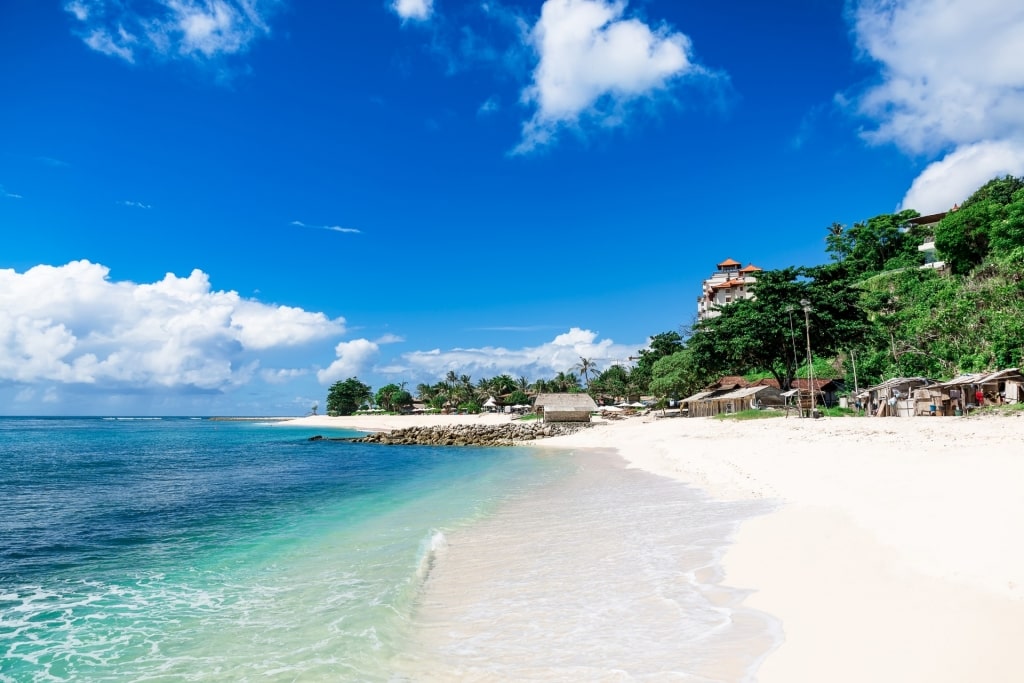The best time to visit Bali depends on what you want to see and do there. Bali, part of the vast Indonesian archipelago, is one of the few destinations in Asia that you can travel to year-round.
As it’s so close to the equator, the temperature varies very little, fluctuating between 82°F and 90°F (28°C and 32°C) throughout the year.
The main seasonal difference in Bali is that November to March tends to be wetter, with short, sharp showers. But this is also a better time for surfing, and there will be fewer crowds in the temples and on the beaches. Visit from April to October and you’ll have less rain.
Whichever time of year you visit Bali, you’ll find colorful temples, emerald rice terraces, art galleries, beaches, and exciting cuisine to explore. The sea is warm for swimming year-round, too.
Visiting Bali by Season
Summer

Beach in Bali
June, July, and August, summer for most of the Northern Hemisphere, is Bali’s dry season. In contrast, much of the rest of Asia is experiencing heavy monsoon rains now, which is what makes Bali so popular with Europeans and North Americans during the summer.
Expect average daily highs of 80.7°F (27°C) throughout this period and relatively little rain. August is the driest month, with just 0.6 inches (15mm) of rainfall on average. August is also the coolest month, all things being relative, with temperatures dropping to 67.5°F (19.5°C) at night on average.
Fall
September to November sees the season changing in Bali. October brings the beginning of rainier weather, when you could experience daily showers. Average daily highs are still a balmy 80.3°F (26.8°C) in September, though, rising to 83°F (28.3°C) by November.
During the rainy season, you can expect brief showers in the morning and the afternoon and usually sunshine for the rest of the day. Expect rainfall from 1.6 inches (40mm) in September to 5.9 inches (150mm) in November.
Winter
December, January, and February bring consistently hot temperatures of around 82.1°F (27.8°C). January is the wettest month, with 13.8 inches (350mm) of rain on average, although this does vary. The southern part of the island, around Denpasar, the capital, and the arty town of Ubud, receives less rain than the north.
When rainy days do come, the mountains may be draped in clouds, which simply adds to the dreamy landscapes of one of Asia’s best islands.

Uluwatu Temple
Spring
March, April, and May again see the season changing. March typically means an average of 8.5 inches (215mm) of rain, dropping dramatically to just 3 inches (75mm) by May.
Expect warm temperatures of around 82.5°F (28°C) throughout spring. Sunshine hours are increasing, rising from seven in March to nine on average in May.
When Is Rainy Season?
The rainy season in Bali is from October to March when the northwest monsoon arrives. But even during the heart of the wetter season, there will still be six or seven hours of sunshine, on average, and time for lying on Bali’s beautiful beaches.
The north of Bali receives more rain than the south, so stay south for a chance of better weather.
When Is High Season?
Bali’s high season is the drier, less humid summer months, from June to September. Short, sharp thunderstorms may still occur, but days are usually clear and sunny. This is the best time to visit Bali if you want to go hiking in the mountains.
When Is Shoulder Season?
The shoulder months are May and October. The weather will be hot and humid, but there are fewer crowds and still plenty of sunny days for exploring some of the best places to visit in Bali, as well as hiking and basking on the beach.
When Is Low Season?
Bali’s low season is the wetter months of January and February, when there’s more rainfall. But it’s important to bear in mind that if you are traveling around Southeast Asia, this is peak season further north, in countries like Singapore, Malaysia, and Thailand, with dry, clear, sunny days. So planning your trip is a question of balance.

Ubud
Do you want to discover more about Bali’s beautiful beaches and fascinating culture? Explore our cruises to Bali and plan your dream vacation.



